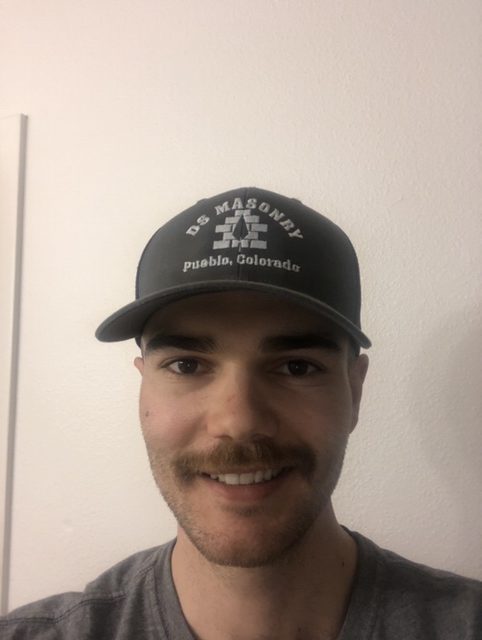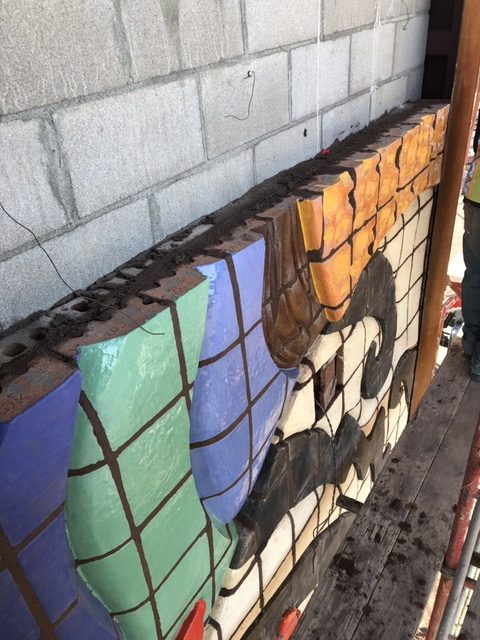Words: MASONRY Magazine
Photos: Max Berry, DS Masonry
Editor’s Note: We had the opportunity to chat with Max Berry, a Mason Foreman at D.S. Masonry in Chandler, Arizona. Max works with his step-father at DS Masonry and already has accomplished much in the masonry industry. Max reached out to us with some impressive pictures of a recent project completed by DS Masonry, and we greatly enjoyed the opportunity to learn more about his background and this unique sculpture. We would like to thank Max for speaking with us and JagClamp for sponsoring this series.
MASONRY Magazine: Tell us a little bit about yourself.
Max Berry: My name is Max Berry, and I’m 25 years old. I was born and raised in Pueblo/Colorado Springs, CO.
M.M.: Awesome, where did you go to school?
M.B.: I went to Pueblo East High School.
M.M.: Did you do any masonry training programs there?
M.B.: No, I actually went to the International Masonry Institute in Maryland.
M.M.: What was your program like there?

M.B.: It was really in-depth. I was there for eight weeks and we went over classwork and hands-on training with really good trainers. It was a union company.
M.M.: Tell us a little more about what you’re doing now, and what you’ve done since school?
M.B.: The company I work for now is called DS Masonry. The “DS” stands for Doug Stout, who’s my stepdad. We were established in 1992, it’s family-owned and operated, and we do commercial and residential masonry in Southern Colorado. We have apprenticeship classes in our shop, and we partnered with Williams Studios to do the sculpture. We’ve done three or four total sculpture projects with them.
M.M.: That’s great. How do you like working in a family business?
M.B.: It’s really nice, you get a few perks being a family member but you get a little bit more credibility and permission to do things that other people really wouldn’t and it brings up a lot of opportunities.
M.M.: Did you always want to work in masonry?
M.B.: I really thought about it. I was going to college to be a doctor, but I started doing masonry work as a summer job I, and I really liked being outside, working with my hands, and I picked it up really fast.
M.M.: You mentioned DS Masonry gives apprenticeship classes in their shop. Have you ever taken any of them, or can you tell me more about them?

M.B.: So we have an instructor from another masonry company up in the Springs that is union. Every Wednesday they have a four-hour class that runs for three years of the apprenticeship after the students get out of the eight-week training program at IMI. We do all kinds of projects, and then we have our local yearly contest, so about a third of that year, they’re practicing a project for that.
M.M.: That’s super interesting! So taking it back to this particular project you sent us the photos for, can you tell me some more about it, like how it was made, the materials used, what machines and techniques you used to make such a unique and colorful project?
M.B.: Yeah! So the project was called “The Gateway to the Southwest” and it’s on Drew Dix Parkway exit I-25 in Pueblo. It was created by H.G.F. architects and Gagliano Structural Engineers. It was funded by private and public grants, and Williams Studio, Mesa Fab, and DS Masonry were the companies that worked on the project. The materials we had were 12-inch block, 8-inch block, modular bricks, custom sculpted bricks, 7/8 “ rebar for the vertical, ⅜” rebar for the horizontal/stirrups, and then the metal is Cor-tan Steel, and it weighs probably 580,000 lbs. It is sitting on 30 micropile caps to the bedrock, and we used a Caterpillar forklift and a Dewalt flexvolt demo saw.
M.M.: That’s a lot of stuff! Did you have fun working with all of those materials?

M.B.: It was such a challenge making that shape and figuring out how all the rebar worked in it.
M.M.: Definitely. So what does creating a project like this mean to you, being able to step back and see the finished product and the work you created?
M.B.: I’m really grateful to be able to work on it, and I’m proud to see the end result and people’s interest in it. Also, I’m excited to see what other projects I’m able to work on because this is really rewarding.
M.M.: So where do you see yourself in 5 years?
M.B.: As a new journeyman, I hope to be a foreman, and personally, I hope to have my house paid off.
M.M.: Those are awesome goals. Can you tell me about some challenges that you’ve faced or overcome in your career so far?
M.B.: Well, since I just started out, not much, but deciding to become a mason, and going to training while working as a mason tender and going to college was probably my biggest challenge.

M.M.: That’s a lot at once. Not to add more to your plate, but have you ever consider competing before in the Skills, or Fastest Trowel, or the SPEC MIX Bricklayer 500® locally or at World of Concrete?
M.B.: Actually, I have done some competitions! I went to Vegas for the Apprentice Contest in 2017 and 2018.
M.M.: Awesome, how did you do?
M.B.: I didn’t place, but I got 5th place both years.
M.M.: That’s great! Tell me about your experience at World of Concrete?
M.B.: I was really excited to go to World of Concrete, seeing all the new tools and products that make all of our working days easier. But seeing all of the really fast bricklayers, it’s just a lot of work to get to that point and to actually do what they’re doing in the field, it’s not very practical I feel like for me to practice and work that much.

M.M.: Do you have any plans to compete in the future, maybe we’ll see you at World of Concrete 2021?
M.B.: I did a little bit of training when I was really motivated to practice brickwork but because I do it on my own time, it’s become really tough on the body. The people that do it are really something else, but I probably won’t compete again any time soon.
M.M.: It’s true, definitely something I couldn’t do myself. So, what would you consider to be your greatest success?
M.B.: I placed first in my local competition during my first year, and then I went to the Western States competition, and I placed first there. The next year, they sent me out to the International Competition in Maryland, Canada and Mexico were there as well, and I placed third in that, so I would say that’s definitely my biggest accomplishment.
M.M.: Congratulations, that is a really great accomplishment. What motivates you to become a better mason?
M.B.: Just improving my masonry knowledge. There are so many materials and techniques to learn about, but also just getting things done clean and the right way, and being respectful to your coworkers and bosses.
M.M.: What do you do to stay up to date with masonry techniques and education?

M.B.: Right now, I am enrolled in the Rocky Mountain Masonry Institute (RMMI), and I’m taking a Masonry Code and Standards class. I have also already taken a class through the program. We have gone over the basics of all the sections in the code, and when I go to the future ones, they’re going to start breaking it down more and start doing the problem-solving parts of the program. It’s awesome advancing my knowledge in this way, and when problems arise on the jobsite, I know exactly where things need to be.
M.M.: What’s your favorite project that you’ve ever worked on?
M.B.: It would have to be this one, it was awesome.
